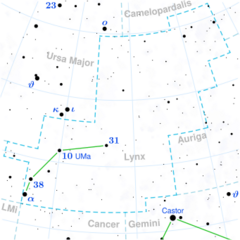Astronomy:Alpha Lyncis
| Observation data Equinox J2000.0]] (ICRS) | |
|---|---|
| Constellation | Lynx |
| Right ascension | 09h 21m 03.30074s[1] |
| Declination | +34° 23′ 33.2245″[1] |
| Apparent magnitude (V) | +3.14[2] |
| Characteristics | |
| Spectral type | K7 III[3] |
| U−B color index | +1.95[4] |
| B−V color index | +1.55[4] |
| Astrometry | |
| Radial velocity (Rv) | 37.15[5] km/s |
| Proper motion (μ) | RA: –223.63[1] mas/yr Dec.: 15.18[1] mas/yr |
| Parallax (π) | 16.06 ± 0.17[1] mas |
| Distance | 203 ± 2 ly (62.3 ± 0.7 pc) |
| Absolute bolometric magnitude (Mbol) | –2.32 ± 0.13[6] |
| Details | |
| Mass | ~2[7] M☉ |
| Radius | 54.50 ± 3.02[6] R☉ |
| Luminosity | 673 ± 83[6] L☉ |
| Surface gravity (log g) | 1.5[5] cgs |
| Temperature | 3,882[5] K |
| Metallicity [Fe/H] | –0.26[5] dex |
| Rotational velocity (v sin i) | 6.4[5] km/s |
| Age | 1.4[7] Gyr |
| Other designations | |
| Database references | |
| SIMBAD | data |
Alpha Lyncis (α Lyn, α Lyncis) is the brightest star in the northern constellation of Lynx with an apparent magnitude of +3.13.[4] Unusually, it is the only star in the constellation that has a Bayer designation.[7] Based upon parallax measurements, this star is located about 203 light-years (62 parsecs) from the Earth.[1]
This is a giant star that has exhausted the hydrogen at its core and has evolved away from the main sequence. It has expanded to about 55 times the Sun's radius and it is emitting roughly 673 times the luminosity of the Sun.[6] The estimated effective temperature of the star's outer envelope is 3,882 K,[5] which is lower than the Sun's effective temperature of 5,778 K, and is giving Alpha Lyncis an orange hue that is characteristic of K-type stars.[9]
Alpha Lyncis is a suspected small-amplitude red variable star[10] that changes apparent magnitude from +3.17 up to +3.12.[11] This variability pattern typically occurs in stars that have developed an inert carbon core surrounded by a helium-fusing shell, and suggests that Alpha Lyncis is starting to evolve into a Mira-type variable.[7]
References
- ↑ 1.0 1.1 1.2 1.3 1.4 1.5 van Leeuwen, F. (2007). "Validation of the new Hipparcos reduction". Astronomy and Astrophysics 474 (2): 653–664. doi:10.1051/0004-6361:20078357. Bibcode: 2007A&A...474..653V.
- ↑ Ducati, J. R. (2002). "VizieR Online Data Catalog: Catalogue of Stellar Photometry in Johnson's 11-color system". CDS/ADC Collection of Electronic Catalogues 2237. Bibcode: 2002yCat.2237....0D.
- ↑ Morgan, W. W.; Keenan, P. C. (1973). "Spectral Classification". Annual Review of Astronomy and Astrophysics 11: 29–50. doi:10.1146/annurev.aa.11.090173.000333. Bibcode: 1973ARA&A..11...29M.
- ↑ 4.0 4.1 4.2 Johnson, H. L. et al. (1966). "UBVRIJKL photometry of the bright stars". Communications of the Lunar and Planetary Laboratory 4 (1): 99. Bibcode: 1966CoLPL...4...99J.
- ↑ 5.0 5.1 5.2 5.3 5.4 5.5 Massarotti, A. et al. (2008). "Rotational and Radial Velocities for a Sample of 761 HIPPARCOS Giants and the Role of Binarity". The Astronomical Journal 135 (1): 209–231. doi:10.1088/0004-6256/135/1/209. Bibcode: 2008AJ....135..209M.
- ↑ 6.0 6.1 6.2 6.3 Piau, L. et al. (2010). "Surface convection and red giants radii measurements". Astronomy and Astrophysics 526: 100. doi:10.1051/0004-6361/201014442. Bibcode: 2011A&A...526A.100P. For Mbol, see Table 1.
- ↑ 7.0 7.1 7.2 7.3 Kaler, J. B. (May 11, 2005). "ALPHA LYN (Alpha Lyncis) and ALSCIAUKAT (31 Lyncis)". Stars. University of Illinois. http://stars.astro.illinois.edu/sow/alphalyn.html.
- ↑ "Alpha Lyncis". SIMBAD. Centre de données astronomiques de Strasbourg. http://simbad.u-strasbg.fr/simbad/sim-basic?Ident=Alpha+Lyncis.
- ↑ "The Colour of Stars". Australia Telescope Outreach and Education. Commonwealth Scientific and Industrial Research Organisation. December 21, 2004. http://outreach.atnf.csiro.au/education/senior/astrophysics/photometry_colour.html.
- ↑ Percy, J. R. et al. (1994). "Photometric surveys of suspected small-amplitude red variables. III: An AAVSO photometric photometry survey". Publications of the Astronomical Society of the Pacific 106 (700): 611–615. doi:10.1086/133420. Bibcode: 1994PASP..106..611P.
- ↑ Kukarkin, B. V. et al. (1981). "Catalogue of suspected variable stars". Nachrichtenblatt der Vereinigung der Sternfreunde E.V.. Bibcode: 1981NVS...C......0K.
 |


